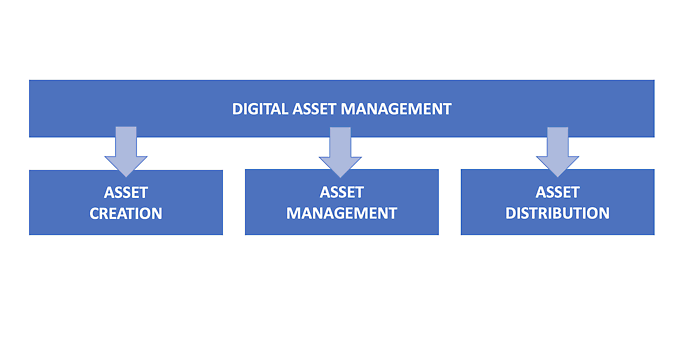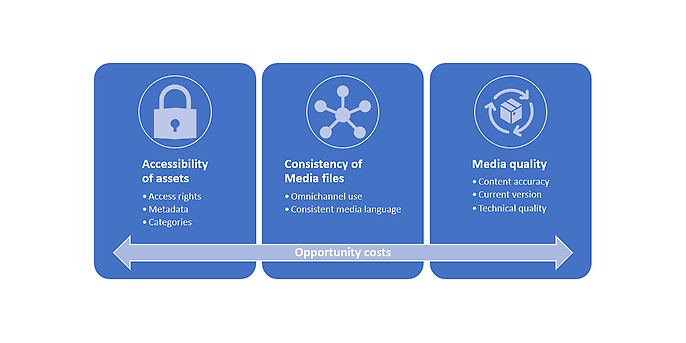17. August 2022 By Axel Ziegler
#1 – An introduction to digital asset management systems
“I already have a product information system, so why should I add a digital asset management system to manage my product images?” I was asked this question in a recent client consultation.
Can you answer the question? If you can’t or if you know only part of the answer, I'd like to give you some insight into what a digital asset management system is and how companies stand to benefit from a digital asset management system.
Let’s start by taking a look at what Wikipedia has to report on the topic. The German entry states: ‘Digital asset management (DAM) refers to software applications for storing and managing any digital content [...]’
What is a digital asset management system?
A digital asset management system, or DAM for short, is software that can be used to centrally store and manage digital media files such as images, films, audio files or documents. A DAM system provides a central platform for the organisation, research, editing and publishing of various media files, among other things.
In this context, ‘central platform’ is of particular importance. Many companies store their digital media on a file server, which is then accessed by employees to select the desired file and save it on their laptop or PC as a copy. They then embed this file in a PowerPoint presentation or e-mail it to an external sales representative. And while they’re at it, they also send the file to other colleagues by e-mail, who then save the file locally, yet again.
This already takes care of explaining most of the two components that make up the term ‘digital asset management’ – ‘digital’ and ‘management’. I will discuss ‘management’ in more detail later. So the one term that still needs to be explained is ‘asset’, or rather, when does a digital media file become an asset?
The asset
The term ‘asset’ is often used in a financial context, where it refers to property, goods or other values. If a media file contains information that is of value to a company, it becomes a digital asset.
But when does a digital media file hold ‘value’? Imagine you are given a photo album of your grandparents. So you open it up to any page and ask your grandparents when this photo was taken, where it was taken and who the people next to your grandparents are. If you’re lucky, someone will have written the caption ‘New Year’s Eve, 1965’ below the photo. Perhaps your grandparents still remember that day and who was with them to celebrate the turn of the year back then.
But what if you have children of your own? What value does this picture hold for your children and grandchildren? The photo shows some strangers at a New Year’s Eve party in 1965. The photo has hardly any value for your children and grandchildren.
For those of you who like to document special events such as vacations, your wedding or the birth of your child in photo books: describe what the picture shows, so when you look at it again years later, the description will help you to refresh your memories.
The metadata
For this photo to become an asset, meaning a valuable commodity, what is missing here is a meaningful description of what can be seen in the photo. Such a description is referred to as metadata. Wikipedia defines metadata as ‘structured data that contains information about characteristics of other data’.
Metadata includes, for example, the description, the recording location, but also the item number, item name, usage rights, licences, product group affiliation, SAP number and many other important pieces of information about the media files that I can store in a DAM and search for in this system.
A DAM system enables the assignment and management of this valuable information in the form of metadata and media file categorisations. They allow a simple media file to become an asset that can be retrieved when needed.
This is even more essential for companies than for private individuals. Even a small business may have thousands of digital media files that need to be managed, from photos of an event to product images, videos, assembly instructions, energy efficiency labels and so on.
For large brands and corporations, the number can easily run into the hundreds of thousands or even millions, and these files are used internally and externally across a wide spectrum of channels. Documents such as product descriptions or instructions must not only be created and stored in a language-specific manner, but they also differ depending on the country where they are to be used. A German-language document with a German DIN standard will not necessarily provide the information needed to meet legal requirements in Austria, where other regulations may apply. And the number of documents that need to be stored together with a product grows incessantly.
Sure, you could argue that all this can be done using a product information system (PIM). But keep in mind that a PIM system focuses on products. It is used to manage product data and product information required to sell and market products. It is not, however, designed to store and manage media files in a meaningful way. PIM systems often simply store the product images and documents on a file server as a repository. A PIM does not offer search and management options tailored to the asset. And PIM systems are not designed to handle the vast data volume associated with assets.
Core tasks of a DAM system
The core tasks of a DAM system can be divided into three areas:

- Asset creation is about providing functions for creating digital assets. This includes the actual import of the media file as well as the capture of metadata stored in the file based on indexing standards such as IPTC, XMP or EXIF.
- Asset management refers to functions for the efficient management of digital assets, which involves assigning categories or versioning assets. It also includes the enrichment of assets with further metadata obtained, for example, by polling metadata from external data sources or third-party systems such as PIM, ERP or PLM systems. Finally, asset management addresses rights and licence management or user administration.
- Asset distribution includes functions that can be used to distribute assets to a wide variety of channels. The foundation for this are extensive and powerful search functions built into the DAM system. Asset distribution includes the provision of assets for manual use – for example, in presentations – or for processing in automated third-party systems such as a PIM, ERP, PLM, CRM or CMS system. DAM systems also offer a wide range of options with regard to the publishing of assets on a wide range of social media platforms (including Facebook, Twitter, Instagram or Tik Tok).
DAM systems thus help companies to overcome the challenges of managing digital media files.

Accessibility of assets
This concerns the question of how metadata can be added to an asset so that the assets can be found and used for downstream use. It is also about how to determine when a specific user may access an asset in order to be able to prevent unauthorised or illegal access to the asset.
Consistency of assets
Making sure that the use of assets in omnichannel marketing and/or sales remains coherent so that the brand language and media terminology is consistent when using digital content.
Quality of media
How to ensure that the right asset is included at the right time in the right channel in the appropriate resolution and format.
Digital asset management systems offer the right answers to all these challenges and support the employees of a company. Essentially, without a DAM system, it takes a company a lot of effort, and this means time and money, to maintain, manage and distribute their assets, which they could have better used elsewhere. Business economists refer to these activities as opportunity costs, that is to say, the cost of lost opportunities; stolen time that is enervating for all persons involved. Or don’t you find it annoying when you are looking for a file that a colleague once created and you have no clue where it was saved or what the file is even called?
The second part of my article addresses the advantages that a digital asset management system offers. So stay tuned!
You will find more blog posts from the adesso world in our latest blog posts.

